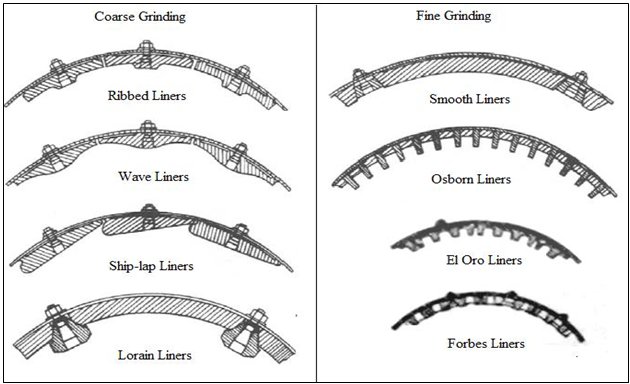The grinding mill liners are integral parts of a grinding mill. Liners are the materials which are used on the inner surface of the grinding shell to provide the necessary strength and resistance. Lining is used on all surfaces with which pulp comes in contact in order to take the wear, and thus conserve the strength and tightness of the barrel structure.
In order to optimize the energy transmission and the surface protection, a liner should have a specified profile. Liners for grinding mills have alternating bars of alloy steel and strips of an elastomer, such as rubber. It is bonded together and to a backing plate which is sufficiently flexible that the liner may be manufactured flat, but drawn against a curved portion of the cylindrical sidewall of the mill by attaching bolts.
Shell liners are usually made in blocks or other shapes of such size that they can be introduced into the interior of the mill through a manhole or the discharge-end opening. Maximum weight of individual blocks ranges generally from 55 to 80 kg.; heavier blocks is difficult to handle manually.
Thickness of the liners determines the interval between replacements and in the case of shell liners, the extent of variation in critical speed, weight of the charge, capacity and the power consumption during this interval.
DIFFERENT TYPES OF LINER PLATES
Some important types of mill liners are shown below, but there are many more different types.
Coarse Grinding: Rib Liner, Wave Liner, Wedge-bar Liner, Ship-lap Liner, Lorain Liner, Straub Liner etc.
Fine Grinding: Smooth Liner, Ribbed plate Liner, Komata Liner, EL Oro Liner, Osborn Liner, Forbes Liner, Silex Liner, Barry Liner, Plymouth Liner, Globe Liner, Pocket liner, Britania Liner etc.

LINER MATERIALS
The most fundamental consideration in selecting a mill liner is that it must have adequate toughness to avoid breaking during use.
Here are various liner materials.
1. Abrasion Resistant (AR) Steel: AR steel is the classification of carbon and alloy steels that are specifically designed for improved abrasion wear.
Advantages include medium cost, wide availability of variance in hardness and alloy composition to custom fit the application, workability and ease of installation, relative low co-efficient of thermal expansion.
Disadvantages include high weight per square foot and noise during impact, corrosion.
2. Ultra High Molecular weight (UHMW) Polyethylene Plastics: HMW is a polyethylene plastic and is available in a variety of formulations. It is generally agreed that either natural cross-linking or chemical cross-linking during manufacturing of the UHMW improves abrasion resistance.
Advantages include low cost, workability and ease of installation, low co-efficient of friction, low water absorption minimizing potential freezing of material to the liner, low weight per square foot, resistance to corrosion.
Disadvantages include relative low resistance to abrasion, relative high co-efficient of thermal expansion.
3. Urethane: Urethane liners are a polyurethane elastomer that is typically available as either ether- based or ester-based. The ether-based urethane liners are typically more expensive but provide better resistance to stress abrasion due to fine particles.
Advantages include medium cost, wide availability of variance in hardness and abrasion resistance, workability and ease of installation, low weight per square foot, noise reduction, resistance to corrosion, relatively low coefficient of thermal expansion.
Disadvantages include toxic fumes from burning, low abrasion resistance in higher velocity pneumatic applications.
4. Ceramic: The most common ceramic liner is a high alumina ceramic. Ceramic is a very hard product that offers excellent resistance to abrasion.
Advantages include excellent resistance to abrasion and extended useful life, low coefficient of thermal expansion, resistance to corrosion, high temperature applications.
Disadvantages include relatively high material and installation cost, subject to breakage.
5. Ceramic Combination Composite: In an effort to capitalize on the high resistance to abrasion in the ceramic and the energy absorbing characteristics in the elastomer, composite liners were developed.
Advantages include enhanced resistance to abrasion with energy absorption of the urethane, resistance to corrosion, noise reduction, relatively low coefficient of thermal expansion.
Relatively high material cost is a disadvantage.
6. Rubber liners: Lifters are made of tough abrasion resistant rubber with decades of field use, guaranteeing their ability to withstand the relentless pounding of the mill action.
Advantages include longer operation life, lower cost, less maintenance, lighter and easier to handle, reduced noise level, reduced weight, no leakage, reduced power consumption increased bearing/pinion life.
Disadvantages include thicker than steel plates hence reduced mill capacity, at high force or speed, dramatic change in wear rate, not good for temperature higher than 800C.
7. Magnetic metal liners: To avoid the rapid wear to the rubber liners, a new technology has been developed by China Metallurgical Mining Cor. The Magnets keep the lining in contact with the steel shell and the end plates without using bolts, while the ball "scats" in the charge and magnetic minerals are attracted to the liner to form a 30-40mm protective layer, which is continuously renewed as it wear.
Advantages include thinner and lighter than steel, increased effective mill volume, decreased power consumption (11.3% decreases), longer life.
8. Grid type liner: This is same type as the magnetic metal liners. The only difference is that it has Grid type structure.
Advantages include lighter weight and cost, longer life, easily hand-able, less weight at the time of discard.
Please input your inquiry in below form. We will reply you as soon as possible








“The first-class professional design services High quality products.”